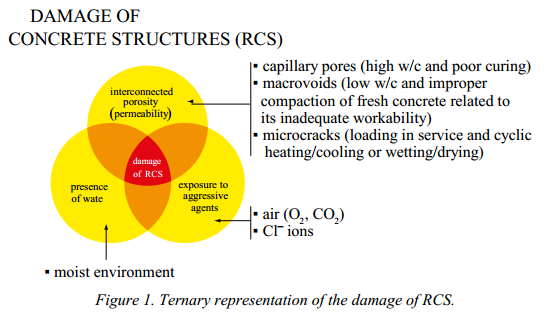Durability of Reinforced Concrete Structures
The New Boundaries of Structural Concrete: Session A – Performance and life?cycle costs of new concrete structures
Memoria tratta da "The New Boundaries of Structural Concrete: Session A – Performance and life-cycle costs of new concrete structures", ACI IC - Bergamo 2013
Reinforced concrete structures can be durable even when exposed to aggressive agents if the porosity of the cement matrix is so low that it becomes discontinuous and then the aggressive agents - in form of CO2, humid air and chloride ions - cannot completely penetrate the concrete cover during the service life of the structures. Figure 1 shows a ternary representation of the damage of rebars in reinforced concrete structure indicating that the damage can occur only when there are interconnected porosity, moist environment and exposure to the aggressive agents.

The European standard EN 206-1 indicate that in order to attain this durable structure the following parameters are required as a function of the exposure class where the structure will be erected:
- a minimum cement (c) content;
- a maximum water/cement (w/c) ratio;
- a minimum cylinder or cubic characteristic strength (fcyl/ck or fcu/ck respectively).
Moreover, the Eurocode 2 indicates the minimum concrete cover thickness (th) as a function of:
- the type of structure (reinforced or prestressed);
- the type of exposure class;
the time of service life of the durable structure (at least 50 or 100 years).
Since the present paper deals specifically with the corrosion of rebars in reinforced concrete structure only two exposure classes will be examined:
- XC4 for structures exposed to cyclic wet and dry;
- XS3 for structures in sea water exposed to tidal, splash, and spray zones.

